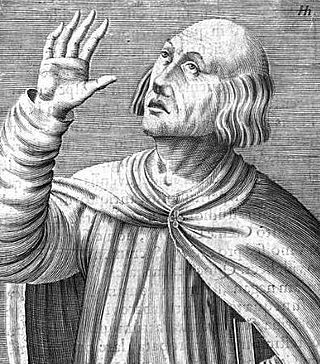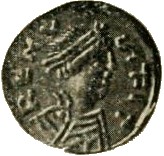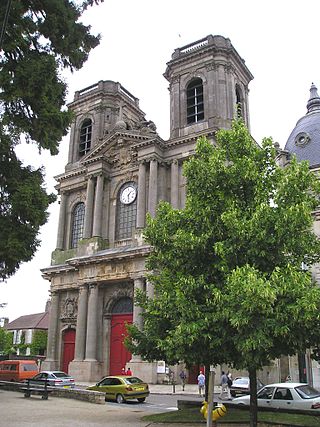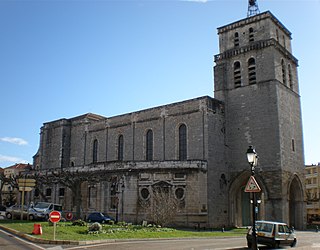Related Research Articles

Berengar of Tours, in Latin Berengarius Turonensis, was an 11th-century French Christian theologian and archdeacon of Angers, a scholar whose leadership of the cathedral school at Chartres set an example of intellectual inquiry through the revived tools of dialectic that was soon followed at cathedral schools of Laon and Paris. Berengar of Tours was distinguished from mainline Catholic theology by two views: his assertion of the supremacy of Scripture and his denial of transubstantiation.

Gregory of Tours was a Gallo-Roman historian and Bishop of Tours during the Merovingian period and is known as the "father of French history". He was a prelate in the Merovingian kingdom, encompassing Gaul's historic region.

Gaius Sollius Modestus Apollinaris Sidonius, better known as Sidonius Apollinaris, was a poet, diplomat, and bishop. Born into the Gallo-Roman aristocracy, he was son-in-law to Emperor Avitus and was appointed Urban prefect of Rome by Emperor Anthemius in 468. In 469 he was appointed Bishop of Clermont and he led the defence of the city from Euric, King of the Visigoths, from 473 to 475. He retained his position as bishop after the city's conquest, until his death in the 480s. He is venerated as a saint in the Catholic church, the Orthodox Church, and the True Orthodox Church, with his feast day on 21 August.

Sigebert I was a Frankish king of Austrasia from the death of his father in 561 to his own death. He was the third surviving son out of four of Clotaire I and Ingund. His reign found him mostly occupied with a successful civil war against his half-brother, Chilperic.

Bruno of Cologne, OCart, venerated as Saint Bruno, was the founder of the Carthusians. He personally founded the order's first two communities. He was a celebrated teacher at Reims and a close advisor of his former pupil, Pope Urban II. His feast day is 6 October.

January 3 - Eastern Orthodox liturgical calendar - January 5

Benignus of Dijon was a martyr honored as the patron saint and first herald of Christianity of Dijon, Burgundy. His feast falls, with All Saints, on November 1; his name stands under this date in the Martyrology of St. Jerome.

The Diocese of Langres is a Latin Church diocese of the Catholic Church comprising the département of Haute-Marne in France.
The Fifth Council of Orléans assembled nine archbishops and forty-one bishops. Sacerdos of Lyon presided over this council. The presence of these bishops indicates both the wide spread of Christianity in Gaul by the sixth century, and the increased influence of the Merovingian kings.
Eufronius or Euphronius was the eighth Bishop of Tours; he served from 555 to 573, and was a near relative of Gregory of Tours.
Saint Munderic of Arisitum was a Coadjutor at the Diocese of Langres between 539 and 572 and later a Bishop of Arisitum circa 600. He was a son of Ansbertus, a senator, and wife Blithilde.

The Archdiocese of Dijon is a Latin diocese of the Catholic Church in France. The archepiscopal see is Dijon Cathedral, which is located in the city of Dijon. The diocese comprises the entire department of Côte-d'Or, in the Region of Bourgogne. Originally established as the Diocese of Dijon in 1731, and suffragan to the Archdiocese of Lyon, the diocese was elevated to the rank of archdiocese in 2002. The most significant jurisdiction change occurred after the Concordat of 1801, when the diocese annexed the department of Haute-Marne. In 1821, a papal bull re-established the Diocese of Langres. Since 2022 the archbishop has been Antoine Hérouard.

The former French Catholic diocese of Alais was created in 1694, out of territory previously part of the diocese of Nîmes. It was suppressed after the French Revolution, with its territory being divided between the diocese of Avignon and the diocese of Mende. Its seat was Alès Cathedral.

The Archdiocese of Clermont is a Latin archdiocese of the Roman Catholic Church in France. The diocese comprises the department of Puy-de-Dôme, in the Region of Auvergne. The Archbishop's seat is Clermont-Ferrand Cathedral. Throughout its history Clermont was the senior suffragan of the Archdiocese of Bourges. It became a metropolitan see itself, however, in 2002. The current archbishop is François Kalist.
Hugh of Langres was bishop of Langres.

Claude de Longwy de Givry (1481–1561) was a French bishop and Cardinal, from an aristocratic background. He was the son of Philippe de Longuy, Seigneur de Givry and Jeanne de Beautremont, Dame de Mirabeau. He had four brothers: Jean de Longuy, Sieur de Givry and Baron de Mirabeau, Christophe de Longuy, Antoine de Longuy, and Étienne de Longuy. Claude's aunt Jeanne had married Guy de la Baume, Count de Montrevel, and one of their sons was Cardinal Pierre de la Baume (1539-1544), Prince and Bishop of Geneva (1522-1543).

March 19 - Eastern Orthodox liturgical calendar - March 21
Gregory of Langres, also called Gregory of Autun, was a Gallo-Roman prelate, born around 446, count of Autun, in Saone-et-Loire then once widowed, towards 500, he becomes bishop of Langres, from 506 to his death in 539. Gregory is a Saint in the Eastern Orthodox Church, which celebrates his feast day on 4 January.

Christianization of the Franks was the process of converting the pagan Franks to Catholicism during the late 5th century and early 6th century. It was started by Clovis I, regulus of Tournai, with the insistence of his wife, Clotilde and Saint Remigius, the bishop of Reims.
Saint John of Réôme was an early Christian abbot in what is now Moutiers-Saint-Jean in the Côte-d'Or department of France.
References
- ↑ Martin Heinzelmann: Gregor von Tours (538–594). „Zehn Bücher Geschichte“. Historiographie und Gesellschaftskonzept im 6. Jahrhundert. Wissenschaftliche Buchgesellschaft, Darmstadt 1994, ISBN 3-534-08348-2, p. 16; Karl Friedrich Stroheker: Der senatorische Adel im spätantiken Gallien. Alma Mater Verlag, Tübingen 1948 (reprinted Darmstadt 1970), p. 223, no. 385.
- ↑ see Venantius Fortunatus carm 4.3.
- ↑ Gregory of Tours was a grandson of his brother.
- ↑ Gregory of Tours, History VIII 5.